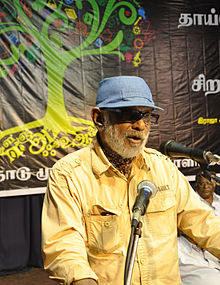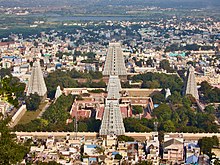Portal:Tamils
The Tamils portal
The Tamils (/ˈtæmɪlz, ˈtɑː-/ TAM-ilz, TAHM-), also known as the Tamilar, are a Dravidian ethnolinguistic group who natively speak the Tamil language and trace their ancestry mainly to the southern part of the Indian subcontinent. The Tamil language is one of the longest-surviving classical languages, with over two thousand years of written history, dating back to the Sangam period (between 300 BCE and 300 CE). Tamils constitute about 5.7% of the Indian population and form the majority in the South Indian state of Tamil Nadu and the union territory of Puducherry. They also form significant proportion of the population in Sri Lanka (15.3%), Malaysia (7%) and Singapore (5%). Tamils have migrated world-wide since the 19th century CE and a significant population exists in South Africa, Mauritius, Fiji, as well as other regions such as the Southeast Asia, Middle East, Caribbean and parts of the Western World.
Archaeological evidence from Tamil Nadu indicates a continuous history of human occupation for more than 3,800 years. In the Sangam period, Tamilakam was ruled by the Three Crowned Kings of the Cheras, Cholas and Pandyas. Smaller Velir kings and chieftains ruled certain territories and maintained relationship with the larger kingdoms. Urbanisation and mercantile activity developed along the coasts during the later Sangam period with the Tamils influencing the regional trade in the Indian Ocean region. Artifacts obtained from excavations indicate the presence of early trade relations with the Romans. The major kingdoms to rule the region later were the Pallavas (3rd–9th century CE), and the Vijayanagara Empire (14th–17th century CE). The island of Sri Lanka often saw attacks from the Indian mainland with the Cholas establishing their influence across the island and across several areas in Southeast Asia in the 10th century CE. This led to the spread of Tamil influence and contributed to the cultural Indianisation of the region. Scripts brought by Tamil traders like the Grantha and Pallava scripts, induced the development of many Southeast Asian scripts. The Jaffna Kingdom later controlled the Tamil territory in the north of the Sri Lanka from 13th to 17th century CE. European colonization began in the 17th century CE, and continued for two centuries until the middle of the 20th century. (Full article...) Selected article -Arunachalesvara Temple (also called Annamalaiyar Temple) is a Hindu temple dedicated to the god Shiva, located at the base of Arunachala hill in the town of Tiruvannamalai in Tamil Nadu, India. It is significant to the Hindu sect of Shaivism as one of the temples associated with the five elements, the Pancha Bhuta Sthalas, and specifically the element of fire, or Agni. Shiva is worshiped as Arunachalesvara or Annamalaiyar, and is represented by the lingam, with his idol referred to as Agni lingam. His consort Parvati is depicted as Unnamulai Amman. The presiding deity is revered in the 7th century CE Tamil Saiva canonical work, the Tevaram, written by Tamil saint poets known as the Nayanars and classified as Paadal Petra Sthalam. The 9th century CE Shaiva saint poet Manikkavacakar composed the Tiruvempavai here. (Full article...) General imagesSelected biography - Balanathan Benjamin Mahendran (19 May 1939 – 13 February 2014), commonly known as Balu Mahendra, cinematographer, director, screenwriter and film editor who worked in various Indian film industries, primarily in Tamil and Malayalam cinema. Born in Sri Lanka, Mahendran developed a passion for photography and literature at a young age, after witnessing the shoot of David Lean's The Bridge on the River Kwai (1957) during a school trip in Sri Lanka, he was drawn towards filmmaking. After graduation he joined as an Aerial photographer in the Sri Lankan Government. In 1966, he moved to India and gained admission to the Film and Television Institute of India (FTII) to pursue a course in motion picture photography. Upon completion of his diploma, he entered Malayalam cinema as a cinematographer in the early 1970s. After working in over 20 films as a cinematographer, Mahendra made his directorial debut in 1977 with the Kannada film Kokila. Since then, he directed over 20 films in a span of 36 years. Along with Bharathiraja and Mahendran, he is regarded as a trendsetter in Tamil cinema. Widely regarded as an auteur, Mahendra usually scripted and edited his films apart from shooting them. He was the recipient of six National Film Awards (including two for Best Cinematography), five Filmfare Awards South and several state government awards. During the tail end of his career, he established a film school in Chennai, which offers courses in cinematography, direction and acting. Following a brief phase of poor health, Mahendra died of cardiac arrest in February 2014. (Full article...) CategoriesTopicsTamil People Countrywide: India • Sri Lanka • Canada • Malaysia • Singapore • South Africa • England Related Ethnic Groups: Brahui • Gond • Kannadiga • Khonds • Kodava • Oraon • Malayali • Telugus • Tuluvas Related indigenous Groups: Badagas • Toda • Kuruba
See also: List of Tamil people, Tamil script, Tamil Script Code for Information Interchange Related portalsWikiProjectsThings to do
Associated WikimediaThe following Wikimedia Foundation sister projects provide more on this subject:
Discover Wikipedia using portals
|


























































